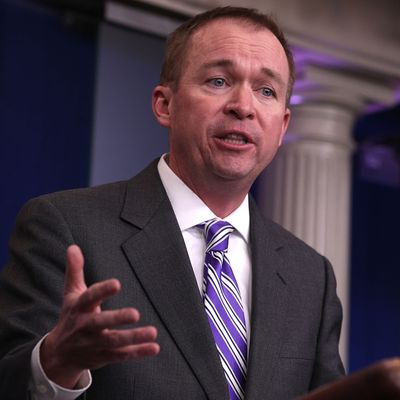
The conservative lobbying group Heritage Action greeted Donald Trump’s first budget (really a budget outline; the full details will come later) with the headline: TRUMP’S BIG LEAGUE CONSERVATIVE BUDGET REQUEST. That’s an appropriate take, and not just because the group’s parent organization, the Heritage Foundation, has left fingerprints all over the proposal, hastily assembled by a less than complete OMB staff. It is, in many respects, a sort of “greatest hits” compilation of conservative prescriptions for paying for a big defense-spending increase with targeted and general cuts in nondefense discretionary programs — domestic spending that is not in one of the big entitlement programs.
The fact that it’s all wrapped up in the bristling “America First” language of nationalist “populism” — with a few distinctive flourishes like a truly neanderthal attack on the State Department that takes one back to the McCarthy era — should not distract from the fact that this is a very conventionally conservative budget prepared by the very conventionally conservative OMB director Mick Mulvaney.
Those who remember the budget wars of the Reagan era will find a lot of blasts from the past in the list of agencies and programs Mulvaney is proposing to shutter entirely: the Appalachian Regional Commission, Community Development Block Grants, the Economic Development Administration, the Legal Services Corporation, Low-Income Home Energy Assistance Program, and the Overseas Private Investment Corporation — all were surviving targets of Reagan’s first budget in 1981. Other targets are products of the later culture wars: federal funding of the arts and culture would be basically eliminated, with the closure of the National Endowment for the Arts, the National Endowment for the Humanities, the Institute of Museum and Library Services, and the Corporation for Public Broadcasting. And still other programs Team Trump seeks to kill involve initiatives associated closely with Democratic presidents, such as the Corporation for National and Community Service (including Bill Clinton’s signature AmeriCorps program) and Barack Obama’s various clean-energy and climate-change initiatives.
Along with the individual constituencies affected, it’s reasonably clear state and local governments will be unhappy with the budget, as they have been unhappy with most Republican presidential budgets over the years. Again and again in Mulvaney’s document you see reductions or eliminations of small grant programs justified as being things states and localities should pay for themselves. And that’s aside from the big-ticket cuts like EPA grants and CDBG (the last significant source of general-purpose funding for local governments).
Another notable and familiar feature of the budget is what you might call cannibalization: Within major agencies Trump priorities are funded by cuts in things his people don’t know or care about. That’s how you wind up with an “America First” budget that hammers a variety of Department of Homeland Defense programs (including the Coast Guard, TSA, and FEMA) in order to shower money on the Wall and border control.
It will be abundantly noted today that the Trump budget document is a strictly hortatory effort. When Reagan released his 1981 budget, his brilliant budget director, David Stockman, had already hatched plans to implement it using an obscure legislative vehicle called “reconciliation,” which enabled Republicans to get much of what they wanted in one huge bill that only required a majority vote. The GOP is again using reconciliation this year, but it’s being largely deployed to repeal and replace Obamacare (not very successfully at the moment, but that’s another story) and then to cut taxes. (Reconciliation can only be used once per fiscal year; the GOP gets to use it twice this time because because Congress never passed a 2017 budget resolution last year.) So the Trump budget’s fate will mostly fall to the Appropriations committees, those notoriously picky barons who tend to reject executive-branch dictation over “their” programs. It’s appropriators and their staffs who are already out there declaring Mulvaney’s handiwork “dead on arrival.”
And that’s probably okay with Team Trump, which seems to be using the whole budget exercise to send messages rather than to get anything done. Mulvaney in effect took off the green eyeshade of the budget wonk and put on his MAGA hat — maybe a military version in khaki — in describing the budget:
“It is not a soft-power budget,” Mulvaney explained. “This is a hard-power budget, and that was done intentionally. The president very clearly wants to send a message to our allies and to our potential adversaries that this is a strong-power administration.”
Yep, it’s a Big League Conservative Budget Request, and like many others, it should be taken with a shaker of salt.






























